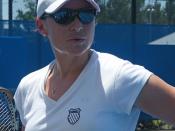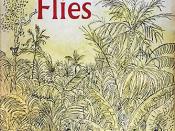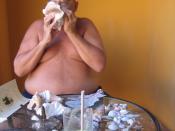Part 1: Lord of the Flies
Compare and contrast the characters you played in Lord of the Flies with the roles of the girls in Act 3 of The Crucible. You must refer to your performance of your role; you must quote specific moments /lines from both plays where relevant.
The Era they are set in, and the way we used movement
In Lord of the Flies our group played the characters as twenty-first century girls, whereas in the Crucible the girls lived in the seventeenth century. This means that expectations regarding their behavior would be very different.
For example, all the characters in Lord of the Flies are able to have their opinions, even Piggy the scapegoat gets a say; 'I'll go to them and say I want my glasses back'. At one point the girls decide to create a fire dance, our group used movements and sounds which were very open and expressive; leaping off tables, stomping and shouting.
This reflects the modern day attitude that children should express their emotions and opinions. In the Crucible though, the girls' troubles started because they expressed themselves dancing naked in the woods. Then to avoid trouble they said that they had been possessed by the devil thus making them not responsible.
This shows the two extremes; on the one hand a seventeenth century society where girls' behavior was repressed, on the other hand the twenty first-century girl were able to express themselves in whatever way they wanted. This is partly because the expected behavior of girls in the twenty-first century was very free compared to the seventeenth century. The girls in Lord of the Flies could make up their own rules whereas in The Crucible the girls had to abide by the rules set by their seventeenth century society.
Group dynamics (themes)
However, despite the plays taking place in different centuries, the themes of the plays, in particular those of truth, lies and events spiraling out of control are common in both. How the two groups of girls interact with other group members show strong similarities in that each person has a place within the dynamics of the group, and each individual's behavior reflects their position within the group and vice versa.
For example Jackie (In Lord of the Flies) is very similar to Abigail (In the crucible), in that both try to be group leaders. Jackie is able to act how she likes, because they are creating their own society. This means that she can be more open in the way she achieves her status. Her main methods are being sarcastic, nasty and putting others down in front of the rest of the group. On the other hand, Abigail has to be very manipulative and devious to gain the status that she craves.
I think that Rebecca (Lord of the Flies) carries similar qualities to Mary (The Crucible) for they both want to do what's right and will stand up for what they believe in. Mary is living in a strict society, making it difficult for a young girl to stand out against her peers (especially the clever and manipulative Abigail). This means that in court she is scared of the punishment if found guilty, and of betraying her friends. Rebecca on the other hand, although she has pressure from her peers, does not have the pressure from the society, because of this she is not in such a complicated situation, it is more clear to her what is the right thing to do and the consequences of her actions. This makes her more bold and daring when does speak out against the group.
So to clarify my point, human nature is such that similar personality traits show in both groups, but they are expressed in different ways.
Group dynamics (power)
The roles of the characters can be understood by the amount of power they have within the group. In Lord of the Flies, my character Simone is a friend of Piggy who is the scapegoat and therefore they have very little power. Rebecca is voted leader 'Becca, Rebecca for leader' which gives her some authority, but the real leader is Jackie aided by Rose. Jackie has the real power.
Jackie uses several techniques to gain power over the other girls, one way is through bullying. An obvious example is when Rebecca, Simone and Piggy are asleep and Jackie and Rose scare them by saying quietly "little pig, little pig, come out of your house little pig" then shouting the last words Rose continues "or I'll huff and I'll puff and I'll blow your house down!" The reaction of the others to this malicious bullying is also very interesting. Rebecca tries and fails to assert her authority by criticizing Jackie and Rose, she shouts "you stupid kids, you stupid bloody kids!" Piggy is just scared senseless and cowers in a corner. Simone (my character) copes by opting out of the situation and becomes philosophical. "Look at the moon...However bad it gets you can always see the moon, and the stars they all have names you know, there's the Plough up there, you can see that from England, you can see that from anywhere in the world." In this speech Simone is reassuring her that despite the circumstances she is part of and still belongs to a bigger world/society, however she fails to confront the bully's about her thoughts.
In The Crucible the roles of the characters are also understood by the amount of power they have within the group. Abigail is the leader who exerts peer-pressure onto the other girls so that they follow their lead. Mary is the only girl who tries to resist the peer-pressure to do what is right. Initially she supports Abigail to avoid punishment, but she realizes that they have gone to far. During the hearing she testifies that "it were pretence sir". Abigail is then faced with two problems, she has a harder job in convincing the court that she is telling the truth, and if the court starts to believe Mary, other girls will be inclined to follow Mary instead of her. Cleverly she gets out of both problems by pretending that Mary has been possessed by the devil and is trying to possesses and hurt her also. The other girls follow her lead and she again is sure of control of the group.
Interaction with characters using Eye contact.
The roles of the characters can also be understood by the audience through the characters interactions with each other, in particular the use of eye contact (or lack of it). Generally my character Simone doesn't make a lot of eye contact with Jackie and Rose, this is because she does not want to be picked on. But she uses eye contact with Piggy when they are alone and is exited about her idea that we came out of the sky. This shows the audience that she is at ease with Piggy.
Eye contact can also be used to convey a message that is not written in the script, it can give away knowledge that you don't want the other person to know. For example, in our production of Lord of the Flies; the girls are trying to make a fire, Simone suggests that they use glass like a magnifying glass; Jackie sarcastically asked, "where do we get glasses from?" I, (as Simone) glanced at Piggy's glasses subconsciously, then realise what I'm doing and look down guiltily, by then though it's to late. Rose followed my glance and realised that they can make a fire by taking Piggy's glasses, and snatches them of her. This tells the audience that Simone knew where they could get glasses from but didn't want to hurt her friend, Piggy.
In The Crucible, I imagine that there would be considerable eye contact by the girls as a means of communication without speaking. However Mary, when going against the group would stare at the floor, not making eye contact with Abigail or the girls as it would be to difficult knowing that she had 'betrayed' them, and that if she made eye contact she might conform to peer pressure. However when Abigail pretends to hallucinate, Mary would probably look into her eye in order to try to influence Abigail and the others to stop. Eye contact is used several times to influence others answers. For instance in the script it says "Danforth: (straight into his eyes) have you ever seen the devil?"
In summing up, eye contact is used in both plays to influence another character and to seek reassurance. However, eye contact can give away your thoughts. In both plays where a character such as mine doesn't agree with the peer group/leader eye contact is minimized.
Movement, gesture and posture
Another way the an actor can help the audience understand the personality and the status of a character, is by the body language the actor uses to play the role. When I played Simone I realised that she did not want to stand out in the group so I did not use large expressive gestures or movements, but moved quietly often with my arms folded staring at the floor. I was quiet, and did not sit up straight but slightly hunched with my legs crossed and head down. This tells the audience that I am a quiet person who likes every body to get along, and be happy, who does not want to stand out, and is very introverted. There were two exceptions where I use larger movements and gestures. One is when I stand at the front of the stage, (a powerful position) and use expressive gestures with my arms and freedom in my voice and with my thoughts. I'm at ease with Piggy (who is with me) and even excited at the prospect of the thought that we might be coming out of the sky, "I bet we came out of the sky, millions of years ago". In this speech Jackie and Rose are absent and so I don't worry that what I'm saying will be immediately criticized and therefore feel free to express myself in speech. My second main time when Simone displays strong movement and gestures is just before when she is killed! She puts herself into danger without realising it, because she is shocked that they 'accidentally' killed a man instead of a beast. She rushes into the center of the circle drawing everybody's attention to her as she says, "It's a man that's all it is, it's a man that got killed. Theirs no beast, it's a man." As she says the second part of the speech it dawns on her that it could have been their intention to kill the man. As a result her gestures cease and her speech dwindles into nothing. Simone (my character) does not want to join in but is bullied into it through Rose's eye contact. Once into the dance she gets carried along and forgets herself and how she feels and is then free to be more extraverted.
Movement gesture and posture was also taken into account by our group to create the fire dance. We used large movements, including jumping of tables, stamping, shouting, using ribbons to express the fire encircling, cracking, and growing. In the peak Jackie reaches to the sky and bellows at the top of her lungs "Fire!"
Piggy is not in the fire dance for her body language tells the audience that she is defensive, shy, and doesn't want to be picked on and can't let go for she is to scared of Jackie. Piggy's body language is the opposite of Jackie's who is very extraverted; she stands tall arms open, and often making wild gestures, and movements.
There are many similarities with the Crucible to Lord of the Flies in the way that they act, therefore some of the character body language is also very similar. I imagine Mary's body language (when testifying against Abigail) is very similar to Piggy's, hugging her and shuffling her feet. This shows that she is uncomfortable in acting different than her peers and standing out to testify against them.
The scene in The Crucible, in which the girls hallucinate, is very similar to the scene in Lord of the Flies of the fire dance in terms of extreme body language, hysteria and repetition of words. This conveys to the audience excitement and frenzy.
In The Crucible the girls begin to 'hallucinate' they become free and expressive in their body language for example they point, gaze, and use strong movements. If it not were these circumstances they would have been punished for using such expressive body language in the seventeenth century.
There are many similarities with the Crucible to Lord of the Flies in the way that they act, therefore some of the character body language is also very similar. I imagine Mary's body language (when testifying against Abigail) is very similar to Piggy's, hugging her and shuffling her feet. This shows that she is uncomfortable in acting different than her peers and standing out to testify against them.
Conclusion
Overall I played Simone as a quiet, sensitive, kind who pities Piggy, Scared to stand up for what she believes in incase she gets bullied, for she prefers not to be confronted. To show this to the audience I reduced my eye contact with the other girls to a bare minimum and generally repressed my gestures unless I was alone with Piggy. In comparing Simone's character to those in The Crucible I think that she is similar to all the girls that follow Abigail because she does not like what's happening but feels that she has no control over it. This makes it clear that she is a follower.


